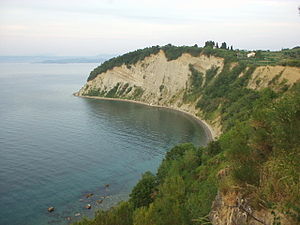User:Vid Pogacnik/Strunjan Nature Reserve


Strunjan Natural Reserve is a part of Park Strunjan and encompasses the northern coast of Strunjan bay with the 200 meters wide sea belt. The area of the whole reserve is 160 ha. The reserve has an extraordinary importance for protecting Slovenian natural heritage, for maintaining ecological stability and biologic variety of the whole Gulf of Trieste.
Nature reserve[edit]
There's only some 20% of Slovenian coast which is still natural (some 4 cm per inhabitant), the rest is modified by man. Out of these 8 km natural coast, including the 200 m wide sea belt, at least one half is protected. There are 4 protected areas, which directly protect also the sea area, and 2 protected areas indirectly linked with the sea. The biggest continuous stretch of nature is 3,8 km long and is protected as the Natural Reserve Strunjan (representing 10 % of the whole coast).
Natural Landmarks[edit]
- The highest flysch cliffs on Adriatic, high up to 80 m, which are constantly modified by sea, wind and rain.
- Mesečev zaliv (Moon Bay), important due to submarine flora and also as a habitat of noble pen shells (pinna nobilis), which grow even up to 1 m.
The cliff of Strunjan is the highest known flysh wall along the whole Adriatic coast. Because flysch is not a very resistant rock it is in its lower part constantly eroded by the sea, and also weathering causes erosion in the upper part. The consequence are interesting geological and geomorfological phaenomena, such as caves, microtectonic faults, broken rock boulders and horizontal or oblique sandstone layers, disappearing under the sea or forming on some places areas of natural pavement just on the coast. Below the cliff, between the sea and the steep slope, there's a characteristic gravel terrace, in some areas up to 7 m broad, on other areas (edges) narrow and passable only at low tide.
Warnings and information[edit]
- From Ronek till Strunjan in summer months anchoring of vessels is forbiddenǃ
- Information boards are located at the bottom of the cliff and along the trail above the cliff.
Access[edit]
- From the Strunjanu swimming area and below the cliff,
- from the church of Sta. Maria and the Cross of Strunjan, above the cliff,
- from Simonov zaliva (bay) and along the coast (below the cliff).
Some examples of local flora are: Seslerio autumnalis, Ostryetum, Spartium junceum and Arundo donax. On the slopes of Ronek, despite the northern orientation and predominantly flysch rocks, some characteristic Mediterranean plants are growing: Myrtus communis and Arbutus unedo, which is autochtone here.
-
Brnistra Spartium junceum
-
Zimzelena mirta Myrtus communis
-
Navadna jagodičnica Arbutus unedo

Some characteristic examples of sea flora and fauna are: Fucus virsoides, Cimodocea nodosa, Zostera noltii, Pinna nobilis, Spirgraphis spallanzanii. Some animals are endangered due to several reasons: Pinna nobilis, Cladocora caespitosa, Lithophaga lithophaga and examples of crabs from the Maia gens.
Outside Links[edit]
- Uredba o Krajinskem parku Strunjan pridobljenoː 21.2.2017
- Uradna stran Krajinskega parka Strunjan pridobljenoː 21.2.2017
See Also[edit]
- The list of Slovenia Natuere Reserves
[[Category:Slovenian Riviera]] [[Category:Nature reserves in Slovenia]] [[Category:Municipality of Piran]]




